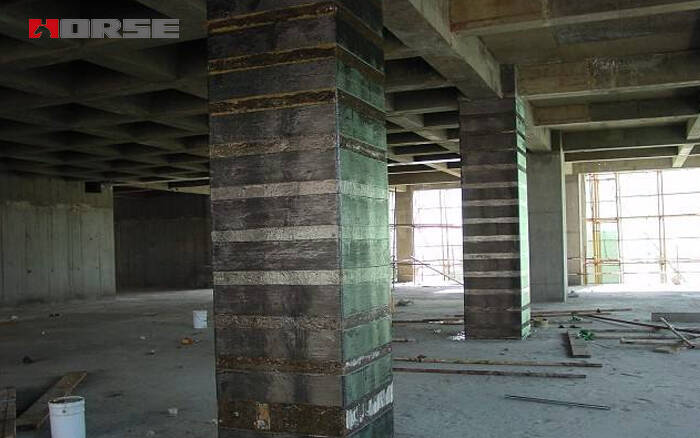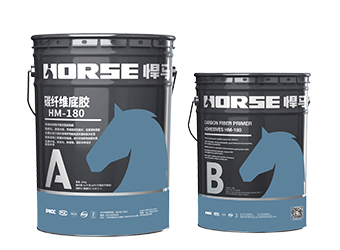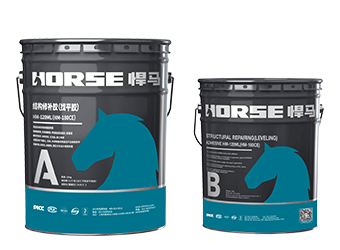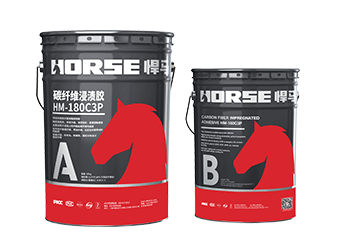Solutions
Horse Construction offers full range of structural strengthening materials with technical supports, documentation supports, products supports, project supports.
primer, repair and leveling adhesive, carbon fiber impregnated adhesive

Carbon fiber reinforced materials (CFRP) strengthening and repairing concrete structure technology is a new structural strengthening and repairing technology that emerged in developed countries such as Japan in the late 1980s and early 1990s. This technology has developed rapidly in our country, and has been widely used especially in the past 10 years. Carbon fiber materials mainly include sheets and plates, and sheets are used the most. The performance and selection of structural adhesives for carbon fiber sheet reinforcement are one of the keys to the successful promotion and application of this technology.
Compared with the bonding steel technology, the carbon fiber sheet reinforcement technology has the following outstanding advantages:
1) CFRP itself is light in weight, basically does not increase the weight of the structure, but its reinforcing effect is no less than that of steel;
2) Good corrosion resistance, strong water resistance and weather resistance;
3) The carbon fiber sheet is relatively soft and can be freely cut according to the shape of the structure without changing the shape of the structure itself, and can also reinforce the wooden structure. This advantage is particularly prominent when strengthening and repairing ancient buildings;
4) Convenient construction, manual operation, simple tools, and less construction space restrictions.
In short, CFRP reinforcement technology can exert a very high reinforcement effect without increasing the load of the structure. It has a wide range of applications, such as the seismic resistance of high-rise buildings, elevated highways, beams, columns, and bridge piers, the load of floor floors and bridge decks, the peeling of concrete, and the expansion of cracks, etc., can all be reinforced with carbon fiber reinforcement technology.
The construction method of carbon fiber sheet reinforcement is as follows:
1) Base surface treatment. Remove floating layer, grease, etc.;
2) Apply primer;
3) Repair and level the base surface;
4) Coating surface glue (dipping glue);
5) Paste the carbon fiber sheet. And make the glue infiltrate into the carbon fiber sheet to form a CFRP composite material system;
6) Brush the protective surface layer.
The main functions and technical requirements of carbon fiber reinforced adhesives
Currently, the widely used carbon fiber adhesives are basically epoxy resin adhesives. Epoxy resin has many excellent properties and is the resin with the best comprehensive performance among thermosetting resins. Carbon fiber adhesives based on epoxy resin have the following characteristics: high mechanical properties, excellent bonding properties, low curing shrinkage, low internal stress, and not easy to crack. The performance of the operation process is good, the wettability to the carbon fiber is good, and the composite material system is easily formed. Strong corrosion resistance, good stability and long storage period.

Carbon fiber sheet reinforcement adhesives are generally used together with 3 kinds of glues:
1) Primer.
The function of the primer is to immerse the irregular surface of the concrete to fill the micropores of the concrete surface through surface adsorption, improve the micropore structure of the concrete surface, and increase the bonding surface area. A strong interface bonding zone is formed, making it stronger than the original concrete surface. The primer is generally a low-viscosity, high-permeability adhesive, and its matrix resin and impregnating glue are basically the same matrix resin to ensure good adhesion of the interface.
2) Repair leveling glue (repair putty).
Repairing and leveling glue is used to repair structural surface defects to ensure uniform force of CFRP and linear force transmission. Generally, it is made of surface glue and filler.
3) Surface glue (carbon fiber impregnated glue).
The carbon fiber sheet is formed by unidirectional arrangement of carbon fiber tows and pre-shaped. It must be fully infiltrated and cured by the impregnating glue to make the carbon fiber filaments and the fabric layers relatively fixed to form a strong composite material layer (CFRP). Therefore, the process performance of the dipping glue must be excellent, that is, the wettability is good, and at the same time, it does not flow when the vertical ceiling is constructed to meet the construction requirements. The mechanical properties should be excellent to achieve reinforcement.
Problems and Improvements in Engineering Application
1) Project quality evaluation issues
In engineering construction, many engineering teams reduce the amount of adhesive in order to save costs. As a result, the primer did not fully penetrate the concrete, and the impregnating glue did not fully infiltrate the carbon fiber sheet, which brought hidden dangers to the quality of the project. At present, the evaluation of project quality is mainly to check whether the performance of the material meets the specification requirements, and conduct on-site pull-out tests (≥2.5MPa, or concrete failure). Since the positive tensile bond strength of the glue is very high (≥30 MPa), the strength of concrete is low (generally ≤5.0 MPa), even if the glue does not completely infiltrate the carbon fiber, the pull-out test may be qualified. So whether it is possible to introduce the index of glue content to control the amount of glue, or to adopt some other testing methods to improve the project quality evaluation.
2) Performance problems of primer
Research by experts at home and abroad shows that the failure of CFRP-reinforced structure basically occurs on the bonding surface of CFRP and concrete. The durability of CFRP material is relatively good, and its sensitivity to environmental media changes is far lower than the bond between CFRP material and concrete. Therefore, the key to the durability of CFRP reinforced concrete structures is to solve the durability of the bonding surface. Therefore, the performance of the primer is very important. At present, most of the primers used in reinforcement projects are solvent-based, or some additives that do not participate in the reaction are added to reduce the viscosity. These additives, on the one hand, produce pores or gaps in the cured product when they volatilize, and on the other hand, the additives cannot be completely volatilized in a short time, which affects the density of the cured product, thereby affecting the corrosion resistance, water resistance and bonding performance. Therefore, the primer is preferably solvent-free. Moreover, the crosslinking density of the cured product of the primer should be increased to increase corrosion resistance and water resistance. At the same time, the primer also needs better toughness to increase the bonding strength under freeze-thaw cycles.
3) Heat resistance issues
Most of the epoxy resin adhesives currently used begin to decrease in strength at 60°C and basically fail at 80°C. Therefore, the lack of high temperature resistance limits its application in many fields. The research direction is to modify the epoxy resin or develop a new matrix resin. The adhesive can not only satisfy the adhesive that can be cured completely at room temperature or even at low temperature (≤5°C), but also meet the bonding strength required for structural reinforcement.
4) Fire prevention problem
Although the currently used adhesives can be flame retardant by adding flame retardants or using halogen-containing epoxy to prepare adhesives. However, after the fire and high temperature, whether the reinforcement performance can still reach the original strength, how much the bonding performance of the adhesive has changed, etc., these issues need to be further explored.
You can find anything here you are in need of, have a trust trying on these products, you will find the big difference after that.

Low viscosity, strong penetration carbon fiber primer for reinforced concrete surface to enhace the defect part

Good thixotropy carbon fiber leveling adhesive for concrete surface repairing

Good impregnation carbon fiber adhesive for applying carbon fiber reinforced polymer(CFRP) wrap for structural strengthening